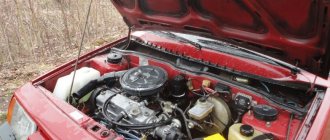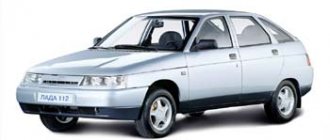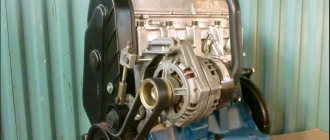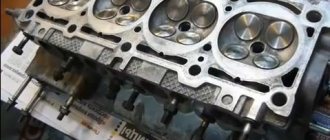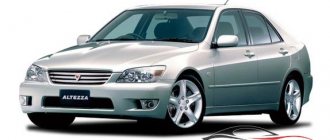I propose to discuss the new eight-valve engine with the VAZ-21116 index - this is a deep modernization of the 1.6-liter engine (VAZ-21114). When buying a car, I heard a lot about the upgraded engine from Granta (the norm). I knew that some kind of lightweight piston group was installed. Winter has come :), I have more time and decided to learn more about the engine. I am pleased with everything that the designers have done with the modernization of the engine, and the fact that the H-intake module has been improved, the pistons have been lightened, the collector has become quieter, and the timing belt tensioner has become automatic. Everything is great except the big one BUT
, which constantly keeps you in suspense.
When the timing belt breaks, the valves bend
and lead to expensive repairs. I’m not used to thinking positively about the domestic engine industry. The manufacturer promised that the timing belt will last 200,000 km, which is hard to believe. And the coolant pump has been improved. I don’t believe that it won’t require replacement no sooner than the car has run 180,000 km. As a rule, a pump malfunction provokes a break in the timing belt. The day before yesterday, a neighbor complained that the timing belt on his car (VAZ-2114) had broken. Work for an hour, replaced with a new one and back on the road. This won't work on Grant anymore. It is necessary to constantly inspect the condition of the timing belt and the condition of the coolant pump. It is well written about the engine HERE: www.zr.ru/a/422396/ cooling system: www.vwts.ru/cooling/cooling_syst_el_regul_rus.pdf
What is your opinion?
This engine on cars of the first years of production had the index 21116, later, without significant technical changes, it received the index 11186, maintaining all its indicators. According to some information, the change in the index is associated with a change in the supplier of the connecting rod and piston group; if in engine 21116 the supplier was Federal Mogul, then in the engine with index 11186 AvtoVAZ independently mastered the production of ShPG.
Engine 21116 is another representative of the power units produced for the Lada Granta. It is considered one of the best representatives of the AvtoVAZ production family. Production of the power unit began in 2011 and continues.
Specifications and description
The VAZ 21116 engine is a direct successor to the Kalinovsky engine 11186, modernized and improved. But, the main base of the engine belongs to the legendary Zhigulevsky engine - VAZ 21083.
So, let's look at the main technical characteristics of the 21116 motor:
| Name | Characteristic |
| Brand | 21116 |
| Marking | 1.6 (1596 cm cube) |
| Power | 87 horsepower |
| Type | Injection |
| Fuel | Petrol |
| Valve mechanism | 8 valve |
| Number of cylinders | 4 |
| Fuel consumption | 7.2 liters |
| Piston diameter | 82 mm |
| Resource | 200 - 250 thousand km |
Service
Maintenance 21116, typical for cars produced by AvtoVAZ. The main maintenance operations are changing the oil and oil filter. To change the lubricant, 3.2 liters of engine oil is required. In turn, 3.5 liters of lubricant fits into the engine.
It is recommended to fill in semi-synthetic motor oils marked 5W-30, 5W-40, 10W-40, 15W40.
The maintenance map looks like this:
TO-1: Oil change, oil filter replacement. Carry out after the first 1000-1500 km. This stage is also called the break-in stage, since the engine elements are grinding in.
TO-2: The second maintenance is carried out after 10,000 km. So, the engine oil and filter are changed again, as well as the air filter element. At this stage, the pressure on the engine is also measured and the valves are adjusted.
TO-3: At this stage, which is performed after 20,000 km, the standard procedure for changing the oil, replacing the fuel filter, as well as diagnosing all engine systems is carried out.
TO-4: The fourth maintenance is perhaps the simplest. After 30,000 km, only the oil and oil filter element are changed.
TO-5: The fifth maintenance is like a second wind for the engine. This time a lot of things are changing. So, let's look at which elements need to be replaced in the fifth maintenance:
- Change of oil.
- Replacing the oil filter.
- Replacing the air filter.
- Replacing the fuel filter element.
- The timing belt and roller are replaced.
- Alternator belt if necessary.
- Water pump.
- Valve cover gasket.
- Other items that need to be replaced.
- Valve adjustment, which adjusts the gas distribution mechanism.
Subsequent maintenance is carried out according to the 2-5 maintenance map for the corresponding mileage.
Malfunctions and repairs
ICE 21116 is based on the 21114 power unit. Unlike its older brother, the piston group is produced by Federal Mogul, which made it possible to lighten the ShPG by 39%. If the timing belt breaks, the valve must bend. These are perhaps serious shortcomings. If the valves are bent, then a major overhaul of the cylinder head is guaranteed.
Frequent malfunctions of 21116 are tripping, and poor starting is due to poor quality of the ignition system and the formation of an air-fuel mixture that does not burn completely.
But these malfunctions are typical for all AvtoVAZ representatives. In this case, the car may still be under warranty service.
H
H
It not only frees you from unnecessary operations, but also ensures correct tension, which affects the service life no less than the quality of the belt itself. If you overtighten, the roller and water pump bearings will suffer. The latter, by the way, has also been modernized: a more reliable bearing and oil seal have been installed, and the performance has also been increased (the unit is from a sixteen-valve engine, only with a pulley for a narrow belt).
Dynamics
External view of engine 21116
This is not a racing car, but there is enough power for both city driving and highway driving. If we compare it with the 16-valve engine of the Lada Granta, which is installed on the Luxury versions, then it has more torque at the bottom. This means that you can drive in 5th gear at a speed of 40 km/h.
For example, you are driving at 5 speed, the traffic light in front lights up red. You release the gas pedal and the car brakes with the engine. The light turns green and you can continue driving in 5th gear even if the vehicle speed has dropped to 40 km/h.
I was pleasantly surprised by the elasticity of the motor. Considering that I previously owned a Priora, and it has a 98 hp engine, then the engine is 87 hp. I like grants better.
H
H
Using computer modeling, we selected the optimal flow section of the gas channels, improving their throughput and reducing inlet losses. Since the power was increased, the engine became more thermally loaded, so it was necessary to include an additional operation in the technological process - heat treatment. By the way, all 16-valve heads pass it. In addition, for the sake of more efficient heat removal, the cross-section of the cooling channels was increased, but only those that really needed it.
Engine Features
Due to the design of the car's cooling system, the engine does not warm up above 80 degrees. The management of AvtoVAZ does not see anything wrong with this; they have an official information letter on this matter. You can read it in the material: What is the operating temperature of an 8 valve engine.
The engine design is as simple as an axe. There are no hydraulic compensators, no sores were noticed. Mostly problems can arise due to malfunctions in the engine management system.
Video of acceleration to 100 km per hour
I haven’t shot my video yet, it’s winter, so we’ll wait for the weather to warm up. That's when I'll post it on our YouTube channel. In the meantime, here's a video from Grantovodov.
Here's another interesting video. It is interesting because the measurement is made using an application with a navigator , which means that the speedometer readings are more accurate if the navigator is well calibrated. Everyone knows that the higher the speed, the more the car’s speedometer lies.
Reliability, weaknesses, maintainability
Reliability
VAZ-21116 is considered a reliable engine. Many car owners are especially pleased with its low-end response. Traction at low speeds is quite satisfactory. Low gasoline consumption also did not go unnoticed.
But there is another category of car enthusiasts who are not satisfied with some of the nuances in the engine. For example, the absence of hydraulic compensators, and therefore frequent adjustment of valve thermal clearances.
There is an inconvenience in this situation, but it does not affect the reliability of the engine. In addition, there are complaints about minor problems during intensive use of the motor. However, this is understandable - the more you drive, the sooner some kind of malfunction will appear. This feature is typical for any engine.
Car service workers express their expert opinion about the VAZ-21116. In their opinion, the motor is absolutely reliable. For the most part, this is due to its configuration with imported parts and components.
Various modifications to internal combustion engine systems significantly increase reliability. So, instead of a mechanical fuel pedal, an electromechanical throttle module (“E-Gas”) is used.
Thanks to this innovation, the ECU controls both the gasoline supply and the air supply. The adjusted mixture enters the cylinders.
Increased reliability of the gas joint. Ultimately, cylinder deformation was significantly reduced. This leads to increased reliability of the engine as a whole, and also has a positive effect on increasing its service life.
Changes in the timing drive have increased its service life. The timing belt has become more reliable. But you shouldn’t be 100% deluded by this. The fact is that as a result of untimely or reduced maintenance, the bearings of the automatic tensioner or water pump can jam, which is rare, but it does happen.
Weak spots
The weaknesses of the VAZ-21116 are characterized by typical flaws of the manufacturer.
Unstable idle speed. The malfunction begins to appear when the sensors fail or problems occur in the operation of the electronic control of the fuel pedal (E-Gas).
In this case, the malfunction can only be detected by diagnosing the engine at a specialized car service center.
Misaligned valves contribute to the appearance of loud knocking noises in the engine compartment. It’s worse if the “authors” of the unauthorized knocking are the main or connecting rod bearings of the crankshaft.
As a rule, extreme wear of the liners causes them to make a loud knock. An inspection of the engine at a service station will reveal the malfunction.
Engine tripping. In most cases, the fault lies with a faulty ignition coil. You need to know that such engine behavior is possible when the valves burn out. And again, you can’t do without a car service.
Overheating of the motor can occur due to a faulty thermostat, or, less commonly, a fan. The malfunction can be easily determined by a decrease in the coolant level and the presence of coolant leaks. Service station specialists will help you find the cause of overheating.
The main trouble is a broken timing belt. In this case, bending of the valves is inevitable.
The belt breaks due to a breakdown of the water pump (a unit not completed by the manufacturer).
As you can see, the culprit of engine weaknesses is mainly the manufacturer. But this does not mean that every engine goes through these thorns.
Noise level
I switched to this car from the Renault Megane 2. My Renault was equipped with a 1.6-liter engine, a power of 113 horses, and the number of valves was 16.
After it, the Granta engine works like a tractor. Regardless of the car's mileage. Even the engine on the carburetor VAZ-21093 seemed quieter to me.
I specifically compared the noise level on a new Grant with a mileage of 5,000 km and on mine with a mileage of 55,000 km. As it warms up, the sound becomes quieter, but most likely you just get used to it.
But it is also worth considering that there are no hydraulic compensators, so you will have to adjust the valves. By the way, the engine in the luxury version (98 hp) also rumbles.
Tuning
Among the available tuning options we can note the following:
- Installation of a sports exhaust system.
- Chip tuning.
- Installation of turbocharging.
The most popular is the installation of turbocharging, which allows you to obtain engine power of 120 horsepower. A compressor with a pressure of 0.5 bar must be used. Simultaneously with the installation of supercharging, the piston group, crankshaft and fuel pump are replaced. This work is complex and only an experienced craftsman can carry it out correctly.
Chip tuning, although it is easy to operate, has not received the popularity it deserves. In total, after such a reconfiguration of the engine using a chip, it is possible to obtain no more than five additional horsepower. An increase in such power is practically not felt and does not give any increase in the dynamics of the car.
Engine life
Under the hood in the “Norma” configuration
The question that causes the most controversy. Officials talk about a mileage of 150,000 km before major repairs; some have traveled 200 thousand km or more without problems. I have a friend who already had his engine repaired at 40 thousand km because the timing belt broke. Yes, the engine here is “plug-in” - this means that if the timing belt breaks, the pistons meet the valves and you can see the fist of friendship.
Engine resource 87 hp. 21116 according to the passport - 150,000 km!
Studying the forums, based on my own experience, I can say that it all depends on how you will operate the engine. The most banal thing: the quality of the oil (choose correctly) and engine operating modes - this is what the mileage before you need to do major repairs depends on.
The risk is especially great if...
Lada Granta why the check engine light is on
If you don’t look after the car, it will force you to take a closer look at it with large and costly repairs. At AvtoVAZ they advise changing the timing belt more often, monitoring the condition of the rollers, tensioners, etc., i.e. Carry out periodic maintenance. Although the factory gives a 120,000 km guarantee on the belt, testing this is a big risk. It is better to monitor it more often and change it in advance, before you have to spend money on a major engine overhaul.
In the fall of 2015, the Lad family of passenger cars was replenished with a top model - the Vesta car, produced in a sedan body. When asking the question “do the valves bend on the Lada Vesta,” you need to clearly imagine what kind of engine we are talking about: a 1.6-liter Russian or Nissan, or maybe the latest VAZ development with the name “21179”.
Here we consider options related to cars currently being produced or those that will begin to be produced in the near future. An 8-valve engine was also developed for Vesta - it definitely does not bend the valves and will definitely not be installed on top-end sedans in 2016.
Read more about the engines equipped with the Lada Vesta line in the material: !
ICE VAZ-21129, 106 “hp” (valve bending)
Under the hood of the 106-horsepower Lada Vesta
A little history. Motor 21129 is a modified version of another engine, namely 21127. The last of them, when the timing belt broke, successfully bent its valves, although grooves were made on the pistons (Fig. 1). The point is that the depth of the grooves was not sufficient: if certain conditions were met, the valve “met” the piston with all the ensuing consequences.
With the transition to a new generation of internal combustion engines, that is, 21129, the design of the pistons was modified. But the external shape has not changed much, and although the recesses remain, their depth is still insufficient.
In theory, the problem with valve bending is typical for all VAZ engines equipped with 4 valves per cylinder. Each new 16-valve engine “inherits” it. The exception is one rarity - the VAZ-2112 internal combustion engine, the volume of which is 1.6 liters.
There, the recesses are made conscientiously (Fig. 2).
122-horsepower engine “21179” (valve bending)
In terms of its design, the internal combustion engine of the VAZ-21179 is not very different from its predecessors. The working volume was increased to 1774 ml, which was achieved by changing the piston stroke length: it was 75.6 mm, it became 84.0 mm.
Elements of the connecting rod and piston group
The piston itself is now better fitted to the cylinder than in engines 21127 and 21129. The distance from the piston pin to the piston bottom has increased by 1.3 mm - to 26.7 mm.
But deeper grooves in the bottom never appeared. The timing mechanism still drives the belt, and if it breaks, the possibility of bending the valves has not been canceled.
The timing drive on 21179 engines is equipped with not one, but two tension rollers. What was done to make the design less susceptible to timing belt stretching.
It says here: the number of tension rollers is two
One of the automatic tensioners may jam, but then its function will be taken over by the second automatic roller.
Pistons that do not bend valves
Piston kits for some “old” 16-valve engines are produced by third-party companies. These parts are equipped with deep recesses. The point is that the piston does not reach the plates and cannot bend the valves.
Tuning piston for internal combustion engines 21126-21127
ShPG elements of different engines (21127, 21129, 21179) are compatible. But there is no need to install pistons from “old engines” into the Vesta engine:
- In ICE 21129, after such “tuning”, friction losses will increase;
- If pistons from the 26th or 27th engine are installed in the ICE 21179, the working volume will immediately change.
The “29th”, as well as the “79th” Lada Vesta engine bends valves only with “VAZ” pistons. But after installing a “tuning” part, do not expect an increase in power. Also, by using non-standard elements, you can greatly reduce the resource (lose the warranty, get unforeseen consequences).
Nissan HR16DE engine (does not bend, there is a chain)
This engine is planned for installation on bodies: , and coupe! Its name is HR16DE, and its displacement is 1.6 liters. Let's look at what the piston crown looks like.
HR16DE engine disassembled
There are no “deep recesses” here.
Now let's pay attention to how the timing drive mechanism works
Nothing but gears and chains
There is no toothed belt here - it is replaced by a chain. It is difficult to imagine the following two situations:
- The chain could have jumped over the teeth of one or more gears;
- One of the elements was damaged so badly that the presence of damage led to rupture.
Do the valves of a Lada Vesta with a Nissan internal combustion engine bend? The answer “no” would be wrong - a circuit break is not excluded. But in reality it will be almost impossible to face such a situation. Let's look at why.
Reviews from car owners about the 87 hp engine.
Most reviews are positive.
Mostly problems occur due to low-quality fuel and lubricants. The engine may start to stall and run intermittently (floating idle, stalls, loss of power, etc.). In this case, the “Check Engine” malfunction icon (indicator) should light up on the instrument panel.
The engine pulls well at low end; on the highway, even with a full load, there is enough power. This is especially noticeable when compared with a Ford Focus automatic: engine capacity 1.6, power 100 horsepower. Granta drives more fun, Focus “deflates” after 80 km per hour. As for Focus - personal experience, I owned just such a car.
Fuel consumption
Even in a mixed cycle with traffic jams, consumption will not exceed 10 liters per hundred!
Fuel consumption is good. Even in a mixed cycle with traffic jams, consumption will not exceed 10 liters per hundred. My consumption is 8 liters in the city, 6 on the highway. This is on 92 gasoline. I checked from tank to tank, it roughly matches the readings of the on-board computer. On 95 gasoline, which is what AvtoVAZ recommends using, fuel consumption should become even less.
If your consumption exceeds the norm, then you need to look for a malfunction. Do not delay troubleshooting, as your engine may be overloaded.
Starting in the cold
In cold weather it starts, even after a long stay. The main thing is a good battery, a working fuel pump and power system.


